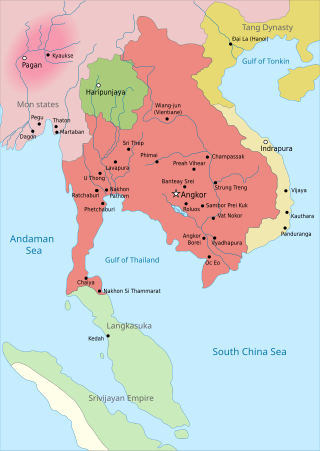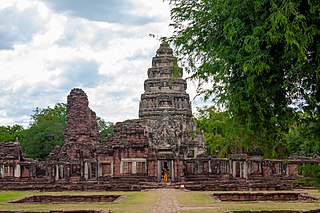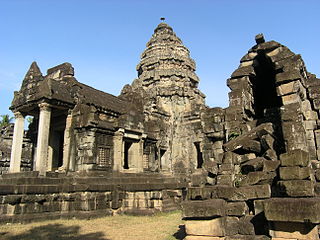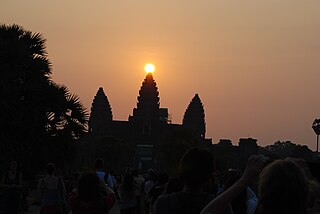Related Research Articles

Khmer architecture, also known as Angkorian architecture, is the architecture produced by the Khmers during the Angkor period of the Khmer Empire from approximately the later half of the 8th century CE to the first half of the 15th century CE.

Phnom Penh is the capital and most populous city of Cambodia. It has been the national capital since the French protectorate of Cambodia and has grown to become the nation's primate city and its economic, industrial, and cultural centre. Before Phnom Penh became capital city, Oudong was the capital of the country.

Angkor, also known as Yasodharapura, was the capital city of the Khmer Empire. The city and empire flourished from approximately the 9th to the 15th centuries. The city houses the Angkor Wat, one of Cambodia's most popular tourist attractions.

Angkor Wat is a Hindu-Buddhist temple complex in Cambodia, located on a site measuring 162.6 hectares. It resides within the ancient Khmer capital city of Angkor. The Guinness World Records considers it as the largest religious structure in the world. Originally constructed as a Hindu temple dedicated to the god Vishnu for the Khmer Empire by King Suryavarman II during the 12th century, it was gradually transformed into a Buddhist temple towards the end of the century; as such, it is also described as a "Hindu-Buddhist" temple.

The Khmer Empire was a Hindu-Buddhist empire in Southeast Asia, centered around hydraulic cities in what is now northern Cambodia. Known as Kambuja by its inhabitants, it grew out of the former civilisation of Chenla and lasted from 802 to 1431. Historians call this period of Cambodian history the Angkor period, after the empire's most well-known capital, Angkor. The Khmer Empire ruled or vassalised most of mainland Southeast Asia and stretched as far north as southern China. At its peak, the Empire was larger than the Byzantine Empire, which existed around the same time.

The Phimai Historical Park is a historical park in Thailand, covering the ancient town of Phimai and the ruins of Prasat Phimai Thai: ปราสาทพิมาย, pronounced[prāː.sàːtpʰí(ʔ).māːj]) the largest ancient Khmer-Hindu temple in Thailand. It is located in the town of Phimai, Nakhon Ratchasima province. It is one of the most important tourist attractions in the province.
The early history of Cambodia follows the prehistoric and protohistoric development of Cambodia as a country in mainland Southeast Asia. Thanks to archaeological work carried out since 2009 this can now be traced back to the Neolithic period. As excavation sites have become more numerous and modern dating methods are applied, settlement traces of all stages of human civil development from neolithic hunter-gatherer groups to organized preliterate societies are documented in the region.

The post-Angkor period of Cambodia, also called the Middle Period, refers to the historical era from the early 15th century to 1863, the beginning of the French protectorate of Cambodia. As reliable sources are very rare, a defensible and conclusive explanation that relates to concrete events that manifest the decline of the Khmer Empire, recognised unanimously by the scientific community, has so far not been produced. However, most modern historians have approached a consensus in which several distinct and gradual changes of religious, dynastic, administrative and military nature, environmental problems and ecological imbalance coincided with shifts of power in Indochina and must all be taken into account to make an interpretation. In recent years scholars' focus has shifted increasingly towards human–environment interactions and the ecological consequences, including natural disasters, such as flooding and droughts.

Battambang is a province of Cambodia in the far northwest of the country. Bordering provinces are Banteay Meanchey to the north, Pursat to the east and south, Siem Reap to the northeast, and Pailin to the west. The northern and southern extremes of the province's western boundaries form part of the international border with Thailand. In addition, Tonlé Sap forms part of the northeastern boundary between Siem Reap and Pursat. Its capital and largest city is Battambang.

Siem Reap International Airport was an international airport serving Siem Reap and Angkor. It opened in 1932 and closed in 2023 upon the opening of Siem Reap–Angkor International Airport. It was the second-busiest airport in Cambodia after Phnom Penh International Airport.

Siem Reap is the second-largest city of Cambodia, as well as the capital and largest city of Siem Reap Province in northwestern Cambodia.

Vat Phou is a ruined Khmer Hindu temple complex in southern Laos and one of the oldest places of worship in Southeast Asia. It is at the base of mount Phou Khao, some 6 kilometres (3.7 mi) from the Mekong in Champasak province.
Cambodia Angkor Air is the national flag carrier airline of Cambodia, with its corporate headquarters and main hub in Phnom Penh. The company slogan is "Proudly Serve the Kingdom".

The archeological complex of Preah Khan Kampong Svay, also known as Prasat Bakan, or Bakan Svay Rolay, is located 100 km east of Angkor, in the Preah Vihear province of Cambodia. It stands as the largest single religious complex ever built during the Angkorian Era, as its exterior enclosure is over 22 km square, even if the isolated location makes it one of the less-visited Angkorian sites.

Wat Althea, also called Prasat Vat Althea, is a 12th-century Hindu temple at Angkor, Cambodia with an active Buddhist temple and cemetery adjacent to the walled ancient structure.
Mahendraparvata is an ancient city of the Khmer Empire era in Cambodia. The existence of the city has been known for decades, but much of it lay concealed by forest and earth. The city was uncovered by an archaeological expedition led by Jean-Baptiste Chevance and Damian Evans in 2012 with the aid of airborne laser scanning technology called LIDAR.

Angkor National Museum is an archaeological museum dedicated to the collection, preservation and presentation of Angkorian artifacts, also to provides information and education about art and culture of Khmer civilization, with collections mainly dated from Khmer Empire's Angkor period circa 9th to 14th-century. Most of the artifacts are discovered in and around the Angkor archaeological sites nearby. The museum is located in Siem Reap, Cambodia, on the way between downtown Siem Reap to northern road leading to Angkor ancient city.
The fall of Angkor, also known as the sack of Angkor or siege of Angkor, was a seven-month siege of the Khmer capital Angkor by the Ayutthaya Kingdom. After the Khmer refused to recognize Ayutthaya authority, the Ayutthaya besieged Angkor and sacked the capital city. The Khmer King Ponhea Yat fled the city to Basan and later to Chaktomuk . Though the Khmer Empire was already in decline, the conquest of Angkor delivered the final blow and the empire fell. Angkor was subsequently abandoned. After the Fall of Angkor, the king moved the capital first to Basan and later to Chaktomuk, initiating the period known as the Post-Angkor period.
Miriam T. Stark is an American archaeologist whose field experience and emphasis of studies have included locations in North America, the Near East and Southeast Asia. She is currently a professor of Southeast Asian Archaeology at the University of Hawai’i-Manoa, a position she has held since August 1995. Having first received her B.A. from the University of Michigan, she went on to complete her M.A and PhD from the University of Arizona. Stark has co-directed the Lower Mekong Archaeological Project (LOMAP), located in southern Cambodia for the past 12 years. Her research focus not only includes the various aspects of political economy, but also on the process of state formation.

The Angkor Wat equinox is a solar phenomenon considered as a hierophany that happens twice a year with spring and autumn equinox, as part of the many astronomical alignments indicative of a "fairly elaborate system of astronomy" and of the Hindu influence in the construction of the vast temple complex of Angkor Wat, in Cambodia.
References
- 1 2 Cassidy, Caitlin (14 September 2023). "Archaeology world mourns Damian Evans, who discovered medieval cities near Angkor Wat". The Guardian. ISSN 0261-3077 . Retrieved 16 September 2023.
- ↑ Tan, Noel Hidalgo (14 September 2023). "[Obituary] Damian Evans". SEAArch - Southeast Asian Archaeology. Retrieved 16 September 2023.
- ↑ Evans, Damian (2007), Putting Angkor on the map : a new survey of a Khmer 'hydraulic city' in historical and theoretical context , retrieved 16 September 2023